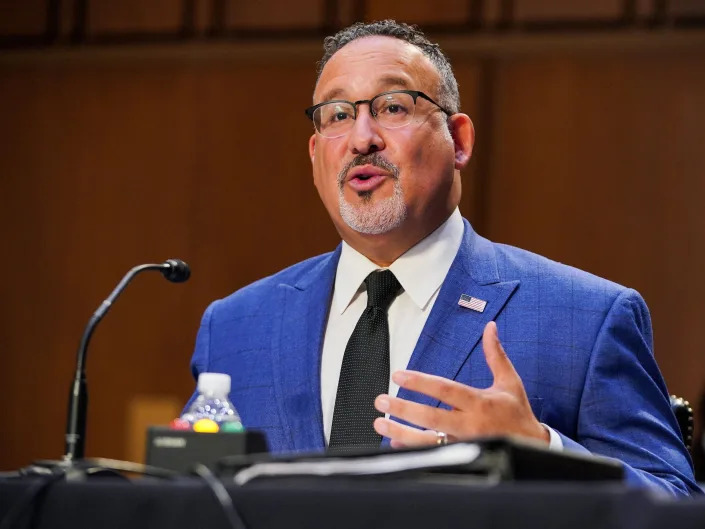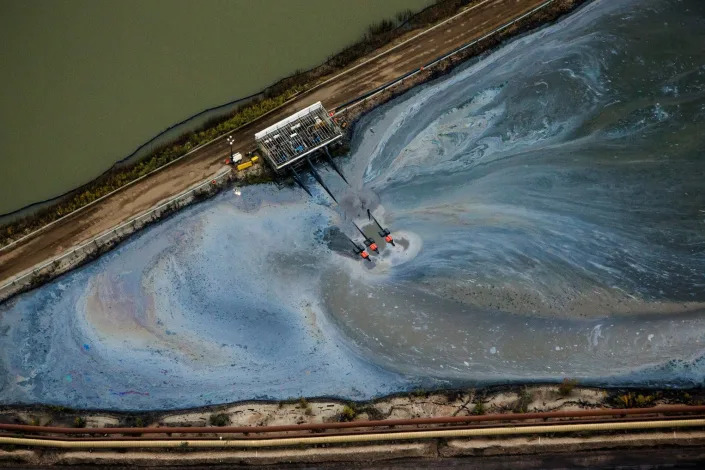Joe Price
Wed, January 26, 2022,

Image via Getty/Drew Angerer
According to a press release from the Department of Education, the Joe Biden administration has canceled $15 billion in student loan debt since he took office.
On Wednesday, the department confirmed more than 675,000 borrowers have benefitted from student loan forgiveness. This is far from all of those who have yet to qualify for loan writeoffs through programs such as Public Service Loan Forgiveness. Although Biden has now eliminated more debt in this area than any other president, the Education Data Initiative indicates over 43 million Americans still owe a total of approximately $1.75 trillion, or roughly $40,000 per student loan recipient.
The statement comes as upwards of 80 House and Senate members shared a letter urging Joe Biden to release a memo that confirms his authority to write off student debt, per CNBC. The lawmakers, who include Chuck Schumer and Elizabeth Warren among them, also said the president should forgive $50,000 per student loan recipient. That would come with a price tag of $1 trillion, but it would cancel debt for 36 million additional students.
Last year, Biden announced his administration would extend the pause on student loan debt payments until at least May 2022. “Given these considerations, today my Administration is extending the pause on federal student loan repayments for an additional 90 days—through May 1, 2022—as we manage the ongoing pandemic and further strengthen our economic recovery,” he wrote. “Meanwhile, the Department of Education will continue working with borrowers to ensure they have the support they need to transition smoothly back into repayment and advance economic stability for their own households and for our nation.”
Prior to that pause, the Education Department paused payments four times.
Biden's Education Department just laid out its plan to make college more affordable — and it didn't include broad student-loan forgiveness
Ayelet Sheffey
Thu, January 27, 2022,

Education Secretary Miguel Cardona.GREG NASH/POOL/AFP via Getty Images
Education Secretary Miguel Cardona outlined his department's priorities in a Thursday address.
One was college affordability, but broad student-loan forgiveness went unmentioned.
Cardona did cite targeted loan forgiveness along with improvements to forgiveness programs.
Education Secretary Miguel Cardona outlined priorities for his department in a speech delivered on Thursday. And while college affordability was a primary focus, broad student-loan forgiveness didn't make the cut.
Cardona's first major address of 2022 laid out how he plans to address four major priorities for his department: supporting students through pandemic recovery, addressing opportunity and achievement gaps, ensuring higher education leads to successful careers, and making higher education more inclusive and affordable.
On the last item, Cardona acknowledged the soaring costs of college and how they can lead to a lifetime of student debt for some of those who seek higher education. But he stopped short of detailing a plan for broad relief.
"It is also unacceptable to be burdened with unmanageable loan debt for several decades because you chose to earn a college degree," he said during his address. "Today too many talented Americans are choosing against enrolling in higher education due to the fear of debt and the feeling that college is out of reach.
Cardona continued: "We maintain a posture of neglect when postsecondary education is out of reach for students and their families. This is un-American."
Here's how Cardona says he plans to tackle college affordability:
Continue providing targeted student-loan relief to certain groups of borrowers, adding to the $15 billion already canceled for those defrauded by for-profit schools and those with disabilities
Enacting stricter enforcement on colleges that mislead and defraud borrowers
Ensuring borrowers have loan-repayment options that match their financial circumstances
Implementing long-term improvements to loan-forgiveness programs like the Public Service Loan Forgiveness program and creating a strong Gainful Employment Rule to ensure borrowers have good job opportunities.
Cardona has already begun to carry out reforms to PSLF, but President Joe Biden's campaign promise of $10,000 in student-loan relief for every federal borrower went unmentioned.
Along with the $15 billion in relief Cardona referenced, Biden has also extended the pause on student-loan payments three times, with the most recent extension being through May 1. And during that time, the Education Department prepared a memo on Biden's legal ability to cancel student debt broadly using executive action — but recently released documents found White House officials saw the memo in April and are choosing not to release it.
That prompted 85 Democratic lawmakers on Wednesday to not only call on Biden to release the memo but also cancel up to $50,000 in student debt per federal borrower before payments resume on May 1. The White House responded to that letter by noting that "no one has been required to pay a single dime" in federal loans under Biden while adding that if Congress sends Biden a bill to cancel $10,000 in student debt per borrower — his campaign promise — he would be happy to do so.
It's unclear when, or if, federal borrowers will experience broad relief. When asked about the issue, Cardona has frequently said that "conversations are continuing" on the issue, but he has not commented on the student-debt memo and says he remains focused on the targeted relief he has already begun to carry out — along with ensuring everyone can access higher education.
"Students, today, with a greater sense of urgency, we re-commit to fulfill the promise to support you as you seek the education that will give you the tools to enjoy life, liberty, and the pursuit of happiness," Cardona said. "Let's get to work."
Ayelet Sheffey
Thu, January 27, 2022,

Education Secretary Miguel Cardona.GREG NASH/POOL/AFP via Getty Images
Education Secretary Miguel Cardona outlined his department's priorities in a Thursday address.
One was college affordability, but broad student-loan forgiveness went unmentioned.
Cardona did cite targeted loan forgiveness along with improvements to forgiveness programs.
Education Secretary Miguel Cardona outlined priorities for his department in a speech delivered on Thursday. And while college affordability was a primary focus, broad student-loan forgiveness didn't make the cut.
Cardona's first major address of 2022 laid out how he plans to address four major priorities for his department: supporting students through pandemic recovery, addressing opportunity and achievement gaps, ensuring higher education leads to successful careers, and making higher education more inclusive and affordable.
On the last item, Cardona acknowledged the soaring costs of college and how they can lead to a lifetime of student debt for some of those who seek higher education. But he stopped short of detailing a plan for broad relief.
"It is also unacceptable to be burdened with unmanageable loan debt for several decades because you chose to earn a college degree," he said during his address. "Today too many talented Americans are choosing against enrolling in higher education due to the fear of debt and the feeling that college is out of reach.
Cardona continued: "We maintain a posture of neglect when postsecondary education is out of reach for students and their families. This is un-American."
Here's how Cardona says he plans to tackle college affordability:
Continue providing targeted student-loan relief to certain groups of borrowers, adding to the $15 billion already canceled for those defrauded by for-profit schools and those with disabilities
Enacting stricter enforcement on colleges that mislead and defraud borrowers
Ensuring borrowers have loan-repayment options that match their financial circumstances
Implementing long-term improvements to loan-forgiveness programs like the Public Service Loan Forgiveness program and creating a strong Gainful Employment Rule to ensure borrowers have good job opportunities.
Cardona has already begun to carry out reforms to PSLF, but President Joe Biden's campaign promise of $10,000 in student-loan relief for every federal borrower went unmentioned.
Along with the $15 billion in relief Cardona referenced, Biden has also extended the pause on student-loan payments three times, with the most recent extension being through May 1. And during that time, the Education Department prepared a memo on Biden's legal ability to cancel student debt broadly using executive action — but recently released documents found White House officials saw the memo in April and are choosing not to release it.
That prompted 85 Democratic lawmakers on Wednesday to not only call on Biden to release the memo but also cancel up to $50,000 in student debt per federal borrower before payments resume on May 1. The White House responded to that letter by noting that "no one has been required to pay a single dime" in federal loans under Biden while adding that if Congress sends Biden a bill to cancel $10,000 in student debt per borrower — his campaign promise — he would be happy to do so.
It's unclear when, or if, federal borrowers will experience broad relief. When asked about the issue, Cardona has frequently said that "conversations are continuing" on the issue, but he has not commented on the student-debt memo and says he remains focused on the targeted relief he has already begun to carry out — along with ensuring everyone can access higher education.
"Students, today, with a greater sense of urgency, we re-commit to fulfill the promise to support you as you seek the education that will give you the tools to enjoy life, liberty, and the pursuit of happiness," Cardona said. "Let's get to work."








